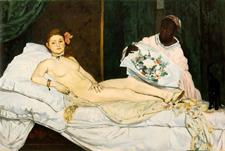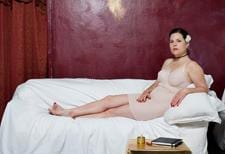
MANET. Olympia by Manet proved one of the most controversial portraits of the 19th Century. Credit: Courtesy of Kate Barry
What is the story behind the woman in the painting? Modern artists have studied and pondered the lives of the Girl with a Pearl Earring, Dora Maar, and the Mona Lisa, the muses that inspired the greatest and most passionate painters. In Ottawa, queer artist Kate Barry physically embodies the subject of Édouard Manet’s Olympia in her new performance piece, which takes place this month at the Axe Neo-7 Gallery in Gatineau.
For her Master’s of Fine Arts final thesis, Barry has created a solo exhibition that examines Victorine Meurent’s career as a model and a painter in her own right. In addition to this current project, over the past ten years Barry has exhibited nationally and internationally, and she is known for the following series: Suffragettes (2000), Andy Warhol (2003), Mud-Flap Girl (2006), Illustrated Woman (2006) and Gender Performance (2007).
Capital Xtra: What inspired you to do this performance piece on Victorine Meurent?
Kate Barry: I designed the performance “Victorine Meurent” as a part of my ongoing investigations around the role of the female body in popular culture and in the art world. Manet’s painting “Olympia” is considered one of the most controversial paintings of the 19th century. In 1863 the painting caused a huge scandal because of the model’s pose and confrontational gaze.
As I began to research more about Manet and this painting, I discovered Victorine Meurent was a real person. Often painters of this era created female nudes from their imagination. I also discovered she was an artist and a lesbian. It was these affinities between Meurent and myself that inspired the performance.
CX: Without giving too much away, could you describe your performance?
KB: In the performance I use the pose of an Odalisque in order to question the significance of that pose. The performance is not a deconstruction of the painting “Olympia”; instead it is a type of one-woman show that focusses on what I perceive to be the strength and determination of Meurent.
The performance is designed for a very intimate audience of six to 10 people, and it runs about 20 minutes. It is interactive in the sense that I try to make a connection with the audience members.
CX: Does your piece focus more on Meurent as a model, or Meurent as a painter?
KB: I focus on Meurent as both model and painter. It is important for me that I give her a voice. I tell a story about her life from the perspective that she is about forty years old and looking back on her life.
CX: In Manet’s painting, the subject is noted for her confrontational gaze that seems to suggest sexual dominance. What do you think the artist was trying to communicate about women and sexuality?
KB: I enjoy the paintings of Manet because he was not afraid to take risks around themes of women and sexuality. In the 19th century this painting was considered hard-core pornography. This is the era before pornography was popularized as a house-hold item. Viewing pornography was an event specific to upper-class men who had access to the salon or private art collections.
Personally I think Manet was trying to create an erotic painting that explicitly shows a high-class prostitute waiting for her client. The perspective of the viewer is one where we are looking in on her as if we are entering the room, or peeping into her private boudoir.
CX: It appears that Meurent never married, but she did live with a woman named Marie Dufour for a number of years. How would she have dealt with being a lesbian in the 19th century?
KB: As we know there is not much written about the history of lesbian art. In my research I discovered that Meurent had the reputation of being a “sexual deviant.” I think she did what she wanted in do and that included having female lovers. It would have been a completely different reality than what we know as “lesbianism” in North America in 2009.
CX: How do your experiences as a queer woman in 2009 translate into this project?
KB: In all of my performances, I draw inspiration from my own life. In this piece, I am able to talk about what it is like to be a queer artist in 2009 through the guise of a nineteenth-century female painter.

 Why you can trust Xtra
Why you can trust Xtra


